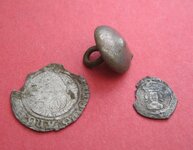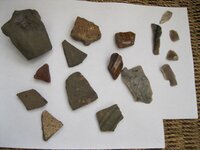robfinds
Silver Member
The great thing about farmers, is they plough things up for us to find. The bad thing is, in doing so they can damage them. These latest two hammered coins prove this sad fact. The largest one is a half groat of Henry VIII, the smaller one, not got an id yet. The button is a 17th century type, rare to find with the shank still attached. The field I've been searching, is liberally covered with pot shards and Neolithic worked flints. All in all a great place to search.
Robert.
Robert.
Attachments
Upvote
14




 . Probably an half penny, had a few of those over the years.
. Probably an half penny, had a few of those over the years.

